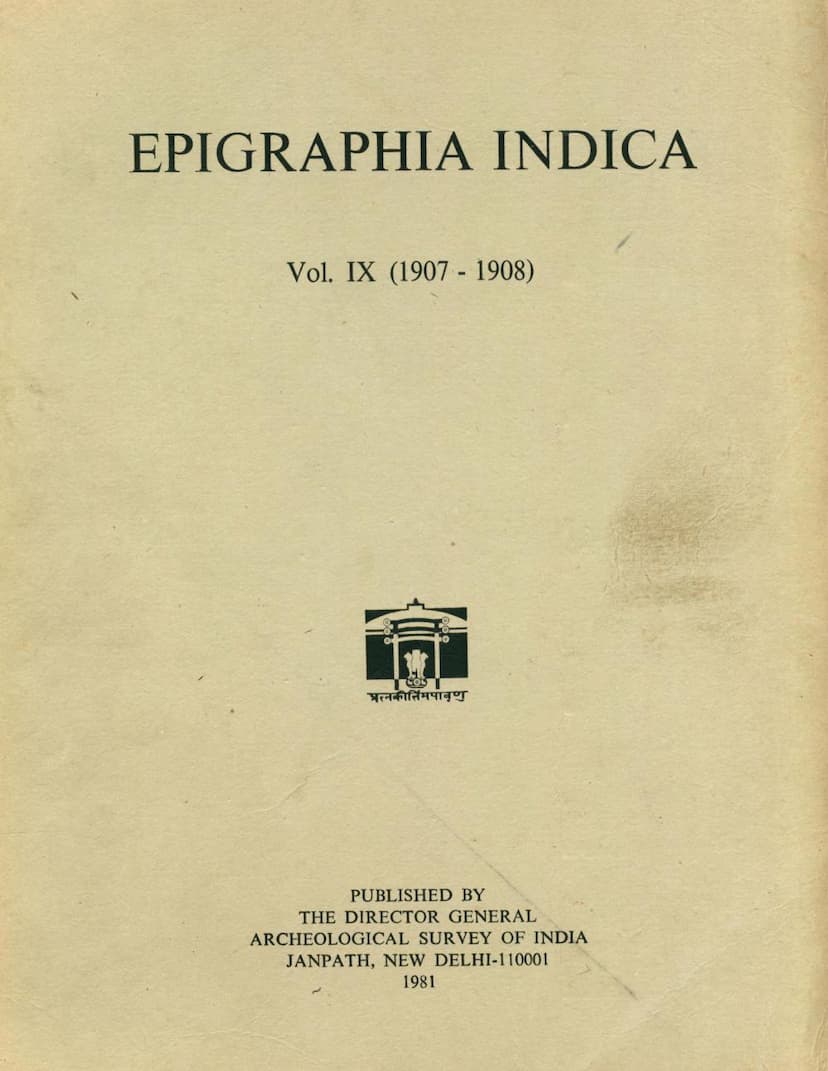Epigraphia Indica Vol 09
Added to library: September 1, 2025

Summary
This document is Volume IX of the Epigraphia Indica, published by the Archaeological Survey of India. It covers inscriptions from 1907-1908 and was edited by E. Hultzsch and Sten Konow. The volume contains a collection of various inscriptions from different regions of India, spanning several dynasties and time periods.
The text includes the following major sections:
- Title Pages and Publication Details: Pages 1-5 provide the title, author information, publisher, and reprint details. It also lists the editors and the various contributors and their respective articles.
- Contents: Page 6 lists the articles included in Volume IX, arranged alphabetically by contributor. This provides a table of contents for the entire volume.
- List of Plates: Page 8 lists the accompanying plates, indicating which inscription each plate illustrates.
- Additions and Corrections: Pages 10-11 provide a list of corrections and additions to previously published material, which is a common feature in scholarly journals to ensure accuracy.
The bulk of the volume consists of the detailed transcriptions, translations, and critical analyses of individual inscriptions. Based on the "Contents" page, the volume features a wide range of inscriptions from various regions and dynasties, including:
- Copper-plate grants: Several articles focus on copper-plate inscriptions, which are royal grants of land or privileges, often detailing genealogies, dates, and administrative information. Examples include grants related to the time of Mahendrapala of Kanauj (No. 1), Indra Raja III (No. 4), Jayavardhana II (No. 6), Ammaraja II (No. 7), Vijaya-Dévavarman (No. 8), and Sankaragana (No. 26).
- Stone inscriptions: The volume also includes inscriptions found on stone pillars, walls, and other architectural elements. These provide insights into religious donations, historical events, and social customs. Examples include the Munddevarli inscription (No. 41), Vasantgadh inscriptions (Nos. 2 and 27), Ghatiyla inscriptions (No. 38), Mamballi plate (No. 32), Krishnapuram plates (No. 62), and the Tirumalai rock inscription (No. 31).
- Inscriptions on specific artifacts: Some inscriptions are found on significant archaeological objects, such as the Mathura Lion-Capital (No. 17).
- Regional Focus: The inscriptions come from various regions, including Pațihelkella, Munddevarli, Vasantgadh, Daulatabad, Ghatiyla, Bastar State, Udiyavara, Mamballi, Krishnapuram, Kanker, Ragholi, Timmapuram, Sarangarh, Burhanpur, Narayanpal, and others, indicating a broad scope of research.
- Chronological Range: The inscriptions cover a significant period of Indian history, with dates provided in various eras such as Gupta Samvat, Harsha Year, Saka Samvat, and Vikrama Samvat, ranging from the Gupta period to later medieval times.
Key Themes and Contributions:
- Genealogies of Royal Families: Many inscriptions are crucial for establishing the genealogies of important dynasties like the Pratiharas, Rashtrakutas, Cholas, Pandyas, Alupas, and the Paramaras of Malava.
- Chronology of Indian History: The volume provides critical dating information for historical events and rulers, helping to refine the chronology of ancient and medieval India.
- Religious and Social History: Inscriptions detailing land grants to temples (Sun temples, Jaina temples, Siva temples), the establishment of religious endowments, and the social customs of the time offer valuable insights into the religious and social fabric of ancient India.
- Linguistic and Paleographic Analysis: The articles often include detailed discussions on the script used, linguistic peculiarities of the Sanskrit or Tamil employed, and paleographic features of the letters, contributing to the study of Indian languages and scripts.
- Geographical Identification: Contributors often attempt to identify ancient place names with their modern counterparts, aiding in the understanding of the geography of historical periods.
- Interpretation of Legends and Customs: Some inscriptions shed light on local legends, administrative practices, and economic activities.
In essence, Volume IX of Epigraphia Indica is a foundational scholarly work for the study of Indian epigraphy and history, providing primary source material with expert analysis for researchers. The detailed treatment of each inscription, including its text, translation, critical notes, and historical context, makes it an invaluable resource for understanding the political, religious, social, and cultural landscape of ancient and medieval India.